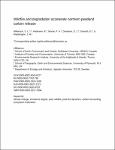Wildfire and degradation accelerate northern peatland carbon release
| dc.contributor.author | Wilkinson, SL | |
| dc.contributor.author | Andersen, R | |
| dc.contributor.author | Moore, PA | |
| dc.contributor.author | Davidson, Scott J. | |
| dc.contributor.author | Granath, G | |
| dc.contributor.author | Waddington, JM | |
| dc.date.accessioned | 2023-04-24T13:54:59Z | |
| dc.date.available | 2023-04-24T13:54:59Z | |
| dc.date.issued | 2023-04-20 | |
| dc.identifier.issn | 1758-678X | |
| dc.identifier.issn | 1758-6798 | |
| dc.identifier.uri | https://pearl.plymouth.ac.uk/handle/10026.1/20755 | |
| dc.description.abstract |
The northern peatland carbon sink plays a vital role in climate regulation; however, the future of the carbon sink is uncertain, in part, due to the changing interactions of peatlands and wildfire. Here, we use empirical datasets from natural, degraded and restored peatlands in non-permafrost boreal and temperate regions to model net ecosystem exchange and methane fluxes, integrating peatland degradation status, wildfire combustion and post-fire dynamics. We find that wildfire processes reduced carbon uptake in pristine peatlands by 35% and further enhanced emissions from degraded peatlands by 10%. The current small net sink is vulnerable to the interactions of peatland degraded area, burn rate and peat burn severity. Climate change impacts accelerated carbon losses, where increased burn severity and burn rate reduced the carbon sink by 38% and 65%, respectively, by 2100. However, our study demonstrates the potential for active peatland restoration to buffer these impacts. | |
| dc.format.extent | 456-461 | |
| dc.language | en | |
| dc.publisher | Springer Science and Business Media LLC | |
| dc.subject | 13 Climate Action | |
| dc.title | Wildfire and degradation accelerate northern peatland carbon release | |
| dc.type | journal-article | |
| dc.type | Journal Article | |
| plymouth.author-url | https://www.webofscience.com/api/gateway?GWVersion=2&SrcApp=PARTNER_APP&SrcAuth=LinksAMR&KeyUT=WOS:000975549100002&DestLinkType=FullRecord&DestApp=ALL_WOS&UsrCustomerID=11bb513d99f797142bcfeffcc58ea008 | |
| plymouth.issue | 5 | |
| plymouth.volume | 13 | |
| plymouth.publication-status | Published | |
| plymouth.journal | Nature Climate Change | |
| dc.identifier.doi | 10.1038/s41558-023-01657-w | |
| plymouth.organisational-group | |Plymouth | |
| plymouth.organisational-group | |Plymouth|Faculty of Science and Engineering | |
| plymouth.organisational-group | |Plymouth|Faculty of Science and Engineering|School of Geography, Earth and Environmental Sciences | |
| plymouth.organisational-group | |Plymouth|REF 2021 Researchers by UoA | |
| plymouth.organisational-group | |Plymouth|Users by role | |
| plymouth.organisational-group | |Plymouth|Users by role|Academics | |
| plymouth.organisational-group | |Plymouth|REF 2021 Researchers by UoA|UoA14 Geography and Environmental Studies | |
| dcterms.dateAccepted | 2023-03-17 | |
| dc.date.updated | 2023-04-24T13:54:42Z | |
| dc.rights.embargodate | 2023-10-20 | |
| dc.identifier.eissn | 1758-6798 | |
| rioxxterms.versionofrecord | 10.1038/s41558-023-01657-w |


